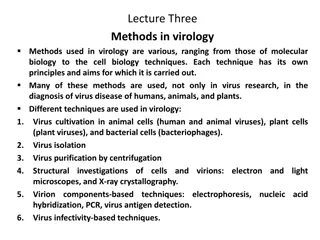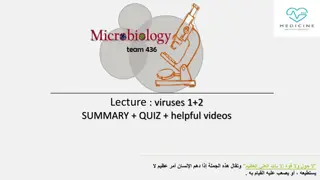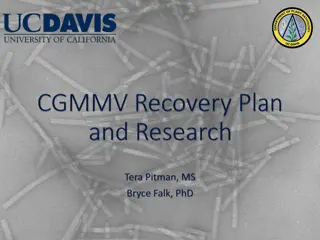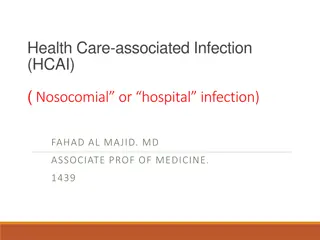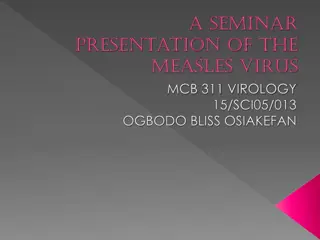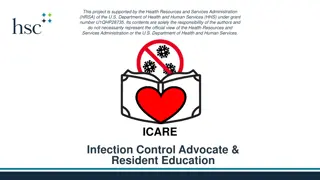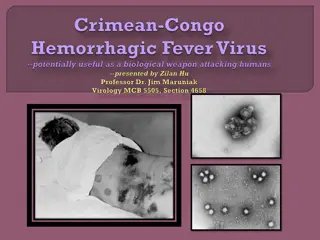Understanding Virus-Cell Interactions and Infections
Viral infections exhibit diverse cellular tropism based on receptor interactions, impacting cell function through modulation and potential host defense responses. Infections can lead to various outcomes, from cell death to persistent or latent states, with nuanced effects on cellular behavior. Different virus-cell interactions highlight the complexity and consequences of viral infections on host cells.
Download Presentation

Please find below an Image/Link to download the presentation.
The content on the website is provided AS IS for your information and personal use only. It may not be sold, licensed, or shared on other websites without obtaining consent from the author. Download presentation by click this link. If you encounter any issues during the download, it is possible that the publisher has removed the file from their server.
E N D
Presentation Transcript
Page|1 VIRUS VIRUS- -CELL CELLINTERACTION INTERACTION cellular tropism of viruses is determined by the presence of appropriate cellular receptors and frequently, cell-type specific transmission factor. Viruses typically encode genes that modulate host-cell function for their own benefit and of course the host has elaborate innate defense to restrict viral functions. Thus the viral and cellular factor that influence the outcome of infection are often in delicate balance and easily shifted one way or the other. Virus infection causes a wide variety of potentiality victorious changes in the many different kinds of cells that occur in the animal host. The disruption of cellular function, the induction of cell death or transformation or the activation of an inappropriate immune response are all potentiality manifested as disease by the infected host. Many virus-cell interactions are transient and asynchronous, involving intermediate steps on the pathway, each featuring dynamic interactions between different viral and cellular components.
Page|2 TYPES TYPESOF Viral infection may be Cytocidal or non cytocydal and productive or non-productive that is, not all infection leads to cell death or the production and release of new versions. However criticalchanges can occur in virus infected cells regardless of whether the infection is productive or not. Some of the most important of all nonproductive virus cell interactions are those associated with persistentinfections or latentinfections. The term persistent infection simply describes an infection that lasts a long time. The term latent infection describes an infection that "exists but is not exhibited," i.e., an infection in which infectious virions is not formed. In either case, the virus or its genome is maintained indefinitely in the cell, either by the integration of the viral nucleic acid into the host cell DNA or by carriage of the viral nucleic acid in the form of an episome. In these instances, the cell survives, indeed may divide repeatedly. In some instances such cells never release virions, in others the infection may become productive when induced by an appropriate stimulus. Persistent or latent infections may also be associated with cell transformation. The various types of interaction that can occur between virus and cell are summarized. OFVIRUS VIRUS- -CELL CELLINTERACTION INTERACTION FIGURE: VIRUS-CELLINTERACTION
Page|3 Types Typesof ofVirus Virus- -Cell CellInteraction Interaction TYPE OF INFECTION PRODUCTION OF INFECTIOUS VIRIONS EFFECTS ON CELL EXAMPLES Cytocidal Morphologic changes in Cells (cytopathic effects); Inhibition of protein, RNA and DNAsynthesis; Cell death Alphaherpesviruses, enteroviruses, Reoviruses Yes No cytopathic effect; Little metabolic disturbance; cells Continue to divide; may Be loss of the special Functions of some Differentiated cells Pestiviruses, Persistent, productive Arenaviruses, rabies virus, most Retroviruses Yes Persistent, nonproductive Canine distemper Virus in brain Polyomavirus, Adenoviruses No,but virus may Be Induced Usually nil Alteration in cell morphology; cells can be Passaged indefinitely; May produce tumors When transplanted to Experimental animals No, oncogenic Murine, avian leukosis, and DNA viruses Transformation sarcoma Viruses Yes, oncogenic retroviruses
Page|4 Figure: Unstained confluent monolayers of the three main types of cultured cells as they appear by low power light microscopy through the wall of the glass or plastic flask in which they form a monolayer. (A) Primary monkey kidney epithelial cells obtained directly by the dissociation of cells from a kidney; this produces a mixed population of mainly epithelial cells. (B) Diploid cell line of fetal fibroblasts. (C) Continuous line of malignant epithelial cells. CYTOCIDAL CYTOCIDALCHANGES CHANGESIN INVIRUS VIRUS- -INFECTED INFECTEDCELLS CELLS Cytopathic viruses kill the cells in which they replicate. When a monolayer of cultured cells is inoculated with a cytopathic virus, the first round of infection yields progeny virus that spreads through the medium to infect adjacent as well as distant cells eventually all cells in the culture may become infected. The resulting cell damage is known as a cytopathiceffect (CPE). Cytopathic effect can usually be observed by low-power light microscopy of unstained cell cultures. Mechanisms Mechanismsof So many pathophysiologic changes occur in cells infected with cytopathic viruses that the death of the cell usually cannot be attributed to any particular event; rather, cell death may be the final result of the cumulative action of many insults. ofCell CellDamage Damage
Inhibition Inhibitionof ofHost HostCell CellNucleic NucleicAcid AcidSynthesis Synthesis Inhibition of host cell DNA synthesis is common in viral infections. It is an inevitable consequence of viral inhibition of host cell protein synthesis and its effect on the machinery of DNA replication, but some viruses employ more specific mechanisms. For example, poxviruses produce a DNAse that degrades cellular DNA, and herpes viruses specifically displace the synthesis of host cell DNA with their own synthetic processes. Inhibition Inhibitionof ofHost HostCell CellRNA RNATranscription Transcription Many different classes of viruses including poxviruses, rhabdoviruses, reoviruses, paramyxoviruses, and picornaviruses, inhibit host cell RNA transcription. In some instances, this inhibition may be the indirect consequence of viral effects on host cell protein synthesis, which decreases the availability of transcription factors required for RNA polymerase activity. In other instances, viruses encode specific transcription factors for the purpose of regulating the expression of their own genes and, in some instances; these factors modulate the expression of cellular genes as well. For example, herpesviruses encode proteins that bind directly to specific viral DNA sequences, thereby regulating the transcription of viral genes. Figure: Cytopathic effects produced by different viruses. The cell monolayers are shown as they would normally be viewed in the laboratory, unfixed and unstained. (A) Typical cytopathology of an enterovirus: rapid rounding of cells, progressing to complete cell lysis. (B) Typical cytopathology of a herpesvirus: focal areas of swollen rounded cells. (C) Typical cytopathology of a paramyxovirus: focal clusters of cells are fused to form syncytia. (D) Hemadsorption: erythrocytes adsorb to infected cells that have incorporated hemagglutinin into the plasma membrane.
Inhibition Inhibitionof Many viruses, including vesicular stomatitis viruses, influenza viruses, and herpesviruses, interfere with the splicing of cellular primary mRNA transcripts that are needed to form mature mRNAs. In some instances, spliceosomes are formed, but subsequent catalytic steps are inhibited. For example, a protein synthesized in herpesvirus- infected cells suppresses RNA splicing and leads to reduced amounts of cellular mRNAs and the accumulation of primarymRNA transcripts. ofProcessing Processingof ofHost HostCell CellmRNAs mRNAs Inhibition Inhibitionof ofHost HostCell CellProtein ProteinSynthesis Synthesis The shutdown of host cell protein synthesis, while viral protein synthesis continues, is a characteristic of many virus infections. This shutdown is particularly rapid and profound in picornavirus infections, but it is also pronounced in togavirus, influenzavirus, rhabdovirus, poxvirus, and herpesvirus infections. With some other viruses, the shutdown occurs late in the course of infection and is more gradual, whereas with noncytocidal viruses, such as pestiviruses, arenaviruses, and retroviruses, there is no shutdown and no cell death. The mechanisms underlying the shutdown of host cell protein synthesis are varied: some are as mentioned earlier, whereas others include (1) the production of viral enzymes that degrade cellular mRNAs, (2) the production of factors that bind to ribosomes and inhibit cellular mRNA translation, and (3) the alteration of the intracellular ionic environment favoring the translation of viral mRNAs over cellular mRNAs. Most importantly, some viral mRNAs simply out compete cellular mRNAs for cellular translation machinery by mass action; i.e., the large excess of viral mRNA outcompetes cellular mRNA for host ribosomes. Viral proteins may also inhibit the processing and transport of cellular proteins from the endoplasmic reticulum, and this inhibition may lead to their degradation. This effect is seen in lentivirus and adenovirus infections. Cytopathic CytopathicEffects Effectsof ofToxic ToxicViral ViralProteins Proteins Large amounts of various viral components may accumulate in the cell late in infection. Most cell damage has been recognized as the supervening of viral replication events on cellular events. Some exceptions for example, the toxicity of adenovirus penton and fiber proteins seems direct and independent of adenovirus replication. Cytopathic CytopathicChanges ChangesInvolving InvolvingCell CellMembranes Membranes Cellular membranes participate in many phases of viral replication, from viral attachment and entry, to the formation of replication complexes, to virion assembly. Viruses may alter plasma
membrane permeability, affect ion exchange and membrane potential, induce the synthesis of new intracellular membranes, and induce the rearrangement of previously existing membranes. A generalized increase in membrane permeability, detected by entry into cells of normally excluded macromolecules or escapes of intracellular molecules, occurs early during picornavirus, alphavirus, reovirus, rhabdovirus, and adenovirus infections. Most importantly, enveloped viruses also direct the insertion of their surface glycoproteins, including fusion proteins, into host cell membranes as part of their budding process, often leading to membrane fusion and syncytium formation. Cell CellMembrane MembraneFusion Fusionand andSyncytium SyncytiumFormation Formation A conspicuous feature of infection of cell monolayers by lentiviruses, paramyxoviruses, morbilliviruses, pneumoviruses, some herpesviruses, and some other viruses is the production of syncytia which result from the fusion of an infected cell with neighboring infected or uninfected cells. Such syncytia may represent an important mechanism of viral spread in tissues. Cell membrane fusion is mediated by viral fusion proteins or fusion domains. NON NON- -CYTOCIDAL CYTOCIDALCHANGES CHANGESIN INVIRUS VIRUS- -INFECTED INFECTEDCELLS CELLS Non-Cytocidal viruses usually don t kill cell in which they will replicate. On the contrary, they often cause persistent infection, in which infected cell produce and release virions but overall cellular metabolism is little affected. In many instances the infected cells even continue grow and divided. Effect Effectof ofNon Non- -Cytocidal CytocidalViral ViralInfection Infectionon onFunction Functionof ofSpecialized SpecializedCell Cell Some viruses such as pestiviruss, arenaviruses and retroviruses that do not shut down host cell DNA, RNA or protein synthesis or do not killed their host cell produce important pathophysiologic changes in their host by affecting crucial functions that are neither associated with the integrity of the cells or their basic housekeeping functions.
Inclusion InclusionBodies Bodies A characteristic morphological change in cells infected by certain virus is the formation of Inclusion Bodies, which may be recognized by light microscopy following fixation and staining. Depending on the virus Inclusion Bodies may be intranuclear or intracytoplasmic, single or multiple, large or small, round or irregular shape and acidophilic or basophilic. Polarity Polarityof ofViral ViralInfection Infection In the course of their replication viruses belonging to several families of enveloped virus insert their glycoprotein into plasma membrane of their host cell,this insertion is not a random matter. For example in reservoir host species rabies virus is shed from the apical surface of salivary gland epithelial cells where it enters the saliva and is transmitted by bite. However, lentiviruses bud from basolateral plasma membranes and pass directly from cell to cell or become disseminated through tissue spaces and the bloodstream. Ultrastructural UltrastructuralChanges Changesin inVirus Virus- -Infected InfectedCells Cells Early changes in cell structure often are dominated by proliferation of various cell membranes: for example, herpesviruses cause increased synthesis, even reduplication, of nuclear membranes; flaviviruses cause proliferation of the endoplasmic reticulum; picornaviruses and caliciviruses cause a distinctive proliferation of vesicles in the cytoplasm; and many retroviruses cause peculiar fusions of cytoplasmic membranes. Other ultrastructural changes that are prominent in many viral infections include disruption of cytoskeletal elements, mitochondrial damage, and changes in the density of the cytosol. Late in the course of infection, many cytolytic viruses cause nuclear, organelle, and cytoplasmic rarefaction and/or condensation, with terminal loss of host cell membrane integrity.









